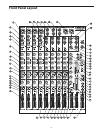
10
Right stereo mix field. You can create a stereo image by
panning some input signals to the left and others to the
right.
20 - 3/4 MUTE switch
The Stereo Input channels feature a 3/4 MUTE switch
allowing you to easily turn that channel on or off. When
3/4 MUTE LED is illuminated, the channel is off, con-
versely, when the LED is off, the channel is on. The switch
also has a second purpose. When the switch is pressed
down, signal from the selected channels is sent to the
3/4 Outputs. This lets you use 3/4 as a second stereo bus
which can be mixed in with the main left and right mix
bus or sent out the 3/4 outputs without being heard in
the main Left and Right mix.
21 – 3/4 MUTE LED
The MDR1248 and MDR1688’s has a 3/4 Mute LED indica-
tor allowing you to easily see if the channel is muted or
assigned to the 3/4 mix bus. When 3/4 MUTE LED is illu-
minated, the channel is off and assigned to the 3/4 bus,
conversely, when the LED is off, the channel is on and not
assigned to the 3/4 mix bus.
22 - Solo switch
The Stereo Input channel’s Solo switch allows you to
listen, or “solo” a channel or group of channels in the
headphones. When the SOLO switch is pressed down, the
channel is assigned to the solo bus and can be heard in
any optional headphones plugged in to the PHONES con-
nector located in the front panel jack field. If the AFL/PFL
MODE switch, located in the master section, is switched
out, the signal is sent pre fader, so you can hear the signal
regardless of the position of the channel volume Fader.
This allows you to listen to a channel by itself: (let's say)
to see if an artist is out of tune, or to cue up a channel
without having to play it through the main PA speakers. If
the AFL/PFL MODE switch is switched in, the signal is sent
post fader, the signal you hear is dependant on the posi-
tion of the channel volume Fader. This allows you to hear
if there is any distortion on a channel added by the level
of the channel fader.
23- SOLO LED
The MDR1248 and MDR1688’s Stereo Input channels
include a SOLO LED which, when illuminated, indicates
that the signal is assigned to the SOLO bus.
24 – PEAK LED
The MDR1248 and MDR1688’s MIC/LINE pre-amp also
includes a PEAK LED which, when illuminated, indicates
that the signal is peaking or overloading. To reduce dis-
tortion, lower the GAIN control to keep this LED from stay-
ing on.
25- VOLUME - Fader Level Control
The VOLUME Fader control adjusts the level of the stereo
channel.
Controls and Functions
Auxiliary Busses ( 16 - 18 )
The MDR series include two auxiliary signal paths, or
buses, that can be used to create independent mixes for
sending to the internal or external effects processors, or
to an external monitor system. The signal flow from these
buses start by sending the signal from each individual
channel, which is set with one of the auxiliary control
knobs. Then, the mix of all the channels auxiliary level is
ultimately sent to either an internal effects processors or
to an output jack to connect to an external effect or moni-
tor system. To help you control your effects and monitor
mixes, the MDR's have two auxiliary buses.
In order to operate your mixer correctly it is important
to understand the concept of PRE and POST fader sends.
For more information on Pre and Post aux sends, see the
previous section “Pre…?, Post?… What’s that?” Located on
page 8 of this manual.
16 – AUX 1
Each of the MDR1248 and MDR1688’s stereo input chan-
nels include an AUX 1 send, which controls the amount of
that channel’s signal that is sent to the AUX 1 Output. The
AUX1 section is often used for a monitor mix in live sound
mixing, or for a headphone mix in a recording applica-
tion. AUX 1 can also be used as a Post Fader effect send
by setting the Pre/Post switch to the Post postion. Each
input channel includes an AUX 1 send which controls the
amount of that channel’s signal that is sent to the AUX
bus.
17 - PRE/POST - switch
The PRE/POST switch is used to select the point that the
AUX 1 bus uses to send the signal. When the PRE/POST
switch is set to PRE, the signal feeding AUX 1 is sent before
the fader, so the channel Fader has no effect on that level.
This is the normal setting when using AUX 1 as a monitor
send. When the PRE/POST switch is set to POST, the signal
feeding AUX 1 is sent after the channel fader, meaning the
Aux level tracks up and down with the channel Fader. This
is the normal setting for using Aux1 as an effects send,
since when you set the channel louder, you normally want
the effect to get louder.
18 – AUX 2 /DSP
Each of the MDR1248 and MDR1688’s stereo input chan-
nels include an AUX 2/DSP send, which controls the
amount of that channel’s signal that is sent to the internal
DSP and/or AUX 2 Output. The signal that feeds Aux 2 is
sent after, or post, the channel Fader, so the channel Fader
has an effect on the Aux 2 level. This is the normal setting
for an effects send, since when you set the channel loud-
er, you normally want the effect to get louder.
19 - BALANCE - Control
The MDR1248 and MDR1688’s BALANCE control is used to
place, or position, the stereo signal into the main Left and


















